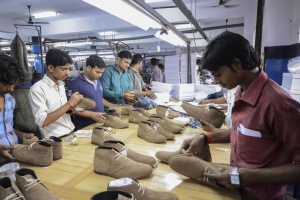Quality Control
Companies only remain on the market if they manage to find other companies or people willing to purchase the products or services that they offer. Competition is a continuous test that forces everyone to be chosen by a sufficient number of customers. The customer and his satisfaction are therefore the company’s reference point; it is he who, through his choices, awards success or failure to the company.
 Quality is an integral part of our organization. Workers are first put on specific training programs before going on online production. Various quality checkpoints are set up and staff is hired to check the on-line and in process production. Moreover, on routine basis production is supervised and improved by the higher management. These certain procedure guarantees us to provide our customer with a unique design shoe of flawless quality and remarkable durability.
Quality is an integral part of our organization. Workers are first put on specific training programs before going on online production. Various quality checkpoints are set up and staff is hired to check the on-line and in process production. Moreover, on routine basis production is supervised and improved by the higher management. These certain procedure guarantees us to provide our customer with a unique design shoe of flawless quality and remarkable durability.
Our quality checking processes are continuously monitored & new improvements are infused into it on continual bases. Every shoe goes through a series of checks to ensure minimal or zero defects before it gets delivered. Some of the checks done are:
Size Measurements Check
Checking footwear dimensions typically involves measuring back height, quarter lateral height, medial quarter height, external toe cap length, and shoe length from heel to toe. Inspectors also measure the lengths of shoes laces, if any, and the dimensions of the shoebox against specifications.
Vulcanization Test of Rubber Outsole
Vulcanized shoes contain polymers that are infused with sulfur to provide more durability, while maintaining the shoes’ elasticity. Basic testing of vulcanized shoes consists of applying tensile stress to the rubber outsole.
Needle Detection Test
Like toys and many other goods manufactured in a factory, shoes need to be checked for needles and any other metal objects that might be hazardous to the consumer.
Flex/Torsion Test
Footwear should be flexible, and one should be able to twist, bend or otherwise contort a shoe to a certain extent with relatively little effort and without damaging the shoe.
Stitch Density Check
Stitch count is an important measure of quality and strength and, as a general rule, an adult shoe should have at least 8-10 stitches per inch, while a child’s shoe should have 10-12 stitches per inch for added strength.
Rocking Test
This test, normally used for inspecting high-heeled shoes.

